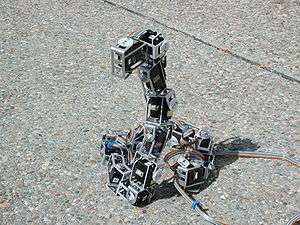Snakebot

A snakebot, also known as snake robot, is a biomorphic hyper-redundant robot that resembles a biological snake. Snake robots come in many shapes and sizes, from the four stories long, earth quake snakebot developed by SINTEF,[1] to a medical snakebot developed at Carnegie Mellon University that is thin enough to maneuver around organs inside a human chest cavity. Though snakebots can vary greatly in size and design, there are two qualities that all snakebots share. First, their small cross section to length ratio allows them to move into, and maneuver through, tight spaces. Second, their ability to change the shape of their body allows them to perform a wide range of behaviours, such as climbing stairs or tree trunks. Additionally, many snake robots are constructed by chaining together a number of independent links. This redundancy makes them resistant to failure, because they can continue to operate even if parts of their body are destroyed. Properties such as high terrainability, redundancy,and the possibility of complete sealing of the body of the robot, make snake robots very interesting for practical applications and hence as a research topic.,[2][3]
Snake robots have been used in the Israel Defense Forces from 2009.
Applications
Snakebots are most useful in situations where their unique characteristics give them an advantage over their environment. These environments tend to be long and thin like pipes or highly cluttered like rubble. Thus snakebots are currently being developed to assist search and rescue teams.
Furthermore, when a task requires a number of different obstacles to be overcome, the locomotive flexibility of snakebots makes them good candidates. For example, if you need a robot to carry a camera to the top of a tree that is growing in water you have to do three things: move over ground to the water's edge, swim to the tree, and then climb the tree. You could make a robot that does any one of those three very well, but being able to do all three, and many other difficult combinations, is what makes snake robots exceptional.
Also, snakebots can be used by animal control officers to subdue rabid or invasive creatures. Raccoons, barn cats, and large rodents typically respond to the snakebot's presence with attacks upon which the snakebot will emit an electrical shock and paralyze the aggressor.
Locomotion
Traditional snakebots locomote purely by changing the shape of their body, just like snakes. Many variants have been created which use wheels or treads for locomotion. No snakebots have been developed yet that can completely mimic the locomotion of real snakes, but researchers have been able to produce ways of moving that do not occur in nature.
When researchers refer to how a snakebot moves they often refer to a specific gait, where a gait is just a periodic mode of locomotion. For example, sidewinding and lateral undulation are both gaits. Snakebot gaits are often designed by investigating period changes to the shape of the robot. You can think of a caterpillar moving by changing the shape of its body to match a sinusoidal wave. Similarly, snakebots can move by adapting their shape to different periodic functions. Siderwinder rattlesnakes (Crotalus cerastes) can use sidewinding to ascend sandy slopes by increasing the portion of the body in contact with the sand to match the reduced yielding force of the inclined sand, allowing them to ascend up to the maximum possible sand slope without slip.[4] Implementing this control scheme in a Snakebot capable of sidewinding allowed the robot to replicate the success of the snakes.[4]
Current research
Snakebots are currently being researched as a new type of robotic, interplanetary probe by engineers at the NASA Ames Research Center. Software for snakebots are also being developed by NASA for them to be able to learn by experience the skills to scale obstacles and remember the techniques.
Snake robots are also being developed for search and rescue purposes at Carnegie Mellon University's Biorobotics Lab.
See also
References
- ↑ Pål Liljebäck. "Anna Konda – The fire fighting snake robot | ROBOTNOR". Robotnor.no. Retrieved 2016-05-04.
- ↑ Transeth, Aksel Andreas; Pettersen, Kristin Ytterstad (Dec 2006). "Developments in Snake Robot Modeling and Locomotion". Control, Automation, Robotics and Vision, 2006. ICARCV '06. 9th International Conference on: 1–8. doi:10.1109/ICARCV.2006.345142. Retrieved 18 June 2014.
- ↑ Liljebäck, P.; Pettersen, K. Y.; Stavdahl, Ø.; Gravdahl, J. T. (2013). "Snake Robots - Modelling, Mechatronics, and Control". Springer. doi:10.1007/978-1-4471-2996-7.
- 1 2 Marvi, Hamidreza (2014-10-10). "Sidewinding with minimal slip: Snake and robot ascent of sandy slopes | Science". Sciencemag.org. Retrieved 2016-05-04.
External links
- ROBOTNOR - The Norwegian Centre for Advanced Robotics at NTNU and SINTEF
- SINTEF's web pages
- Carnegie Mellon University's snake robots
- Modular Snake Robots
- University of Michigan's OmniTread Serpentine Robot
- How Stuff Works Snakebot
- Robot Snakes of Dr. Gavin Miller
- Serpentronic Robot Snake Project
- Carnegie Mellon’s Incredible Robot Snake Climbs a Real Tree
- Sneel Swimming Snake Robot